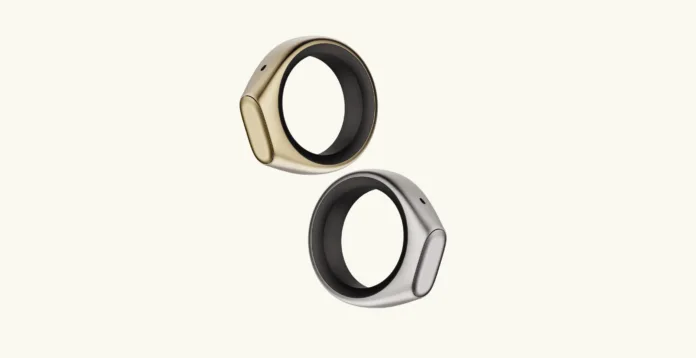Table of Contents
SquaredTech has been tracking the fast-growing AI hardware movement, and few launches have captured as much attention as Sandbar’s Stream smart ring. Built by two former Meta engineers, the Stream ring introduces a radical new way to interact with artificial intelligence, using nothing but your voice and your finger.
Read More About Our Article of RingConn Gen 2 Air Is the Best Budget Health Tracking Ring Right Now Published on June 8th, 2025 SquaredTech
Stream Smart Ring: How Former Meta Engineers Are Redefining Voice-Based AI
The Stream ring allows users to record private voice notes, chat with an AI assistant, and control music playback. Sandbar, the company behind the device, describes it as “a mouse for voice,” an analogy that highlights its goal: to make voice interaction as intuitive and accessible as using a computer mouse.
Sandbar’s CEO Mina Fahmi and CTO Kirak Hong both bring strong backgrounds in human-computer interface design. Fahmi worked on neural interface projects at Kernel and Magic Leap, while Hong previously worked at Google and CTRL-Labs, the startup Meta acquired in 2019 to develop neural control technologies for smart wearables. Their combined experience shapes the Stream ring’s purpose: a small, intelligent, and deeply personal tool for seamless AI interaction.
The concept arrives at a time when voice-based devices are multiplying rapidly. Companies like Plaud, Pocket, Friend, Limitless, and Taya are all experimenting with microphones, pins, and pendants that can capture thoughts and control tasks. Yet, according to our team’s analysis, few have achieved the balance between privacy, simplicity, and real-world utility that Sandbar aims for with Stream.
Inside the Stream Ring: A Compact Voice Interface with AI Power
At first glance, the Stream ring looks like an elegant piece of jewelry. But behind its minimal design lies a sophisticated mix of microphones, sensors, and touch input technology. Worn on the index finger of the dominant hand, the device activates when the user presses and holds the touchpad.
During a virtual demonstration, Fahmi showcased how Stream captures voice notes. By pressing the ring’s surface, the microphone turns on, recording everything the user says until released. The microphone is off by default, decision Sandbar made to prioritize user privacy. Yet, despite its small size, the device can pick up whisper-level speech and transcribe it accurately through the companion iOS app.
The Stream app integrates directly with an AI chatbot, creating a conversational system that evolves with each use. Users can record thoughts, brainstorm ideas, or plan tasks while the AI provides context, suggestions, and summaries. Notes can be organized, reviewed, and edited either manually or with the help of the AI.
One of the app’s most innovative elements is its timeline interface. Users can pinch to zoom out and see all past conversations across days or weeks, turning casual notes into a structured journal. Sandbar has also introduced a personalization layer, the AI’s voice can mimic the user’s tone for a more natural interaction.
In noisy environments, users can wear headphones for private conversations with the assistant. When using Stream without audio accessories, the ring provides haptic feedback, a subtle vibration confirming that notes or commands have been successfully recorded. This silent interaction model makes Stream ideal for work meetings, public spaces, or creative sessions where discretion matters.
Our analysis suggests that this gesture-based interaction system could set a new usability standard for AI-powered wearables, where activation and control are effortless, silent, and intuitive.
Beyond Voice: Stream as a Smart Controller and AI Companion
Stream’s functions extend far beyond note-taking. Its flat touch surface also works as a media controller, allowing users to play, pause, skip tracks, and adjust volume with simple gestures. While many modern headphones already offer these controls, Stream’s design makes it useful in situations where hands are busy or traditional interfaces are inconvenient such as during commutes, workouts, or cooking.
The simplicity of this feature highlights Sandbar’s core philosophy: interaction without interruption. Fahmi explained that Stream is not intended to replace existing devices like smartphones or laptops, but to reduce dependency on them for quick, repetitive actions.
In Fahmi’s words, Stream is “a way to express ideas naturally,” not an AI assistant or companion. This philosophy distinguishes Sandbar from companies like Humane, Rabbit, and Friend, which market their products as AI-powered companions. Stream’s approach centers on control, expression, and privacy values that we note resonate with modern users seeking simpler, more secure ways to use AI.
The company opened preorders for Stream starting at $249 for the silver version and $299 for the gold version, with shipping expected by next summer. Sandbar also introduced a Pro subscription plan that costs $10 per month after a free three-month trial, providing unlimited chats, notes, and early access to new features.
For data-conscious users, Fahmi emphasized that all user data is encrypted both at rest and in transit. Sandbar has pledged full transparency, allowing users to export their recordings and transcripts to third-party platforms like Notion. This openness contrasts with many tech ecosystems that restrict data sharing within proprietary systems.
Stream’s Founders, Funding, and Market Vision
Sandbar’s vision has already attracted significant investor confidence. The company has raised $13 million in funding from True Ventures, Upfront Ventures, and Betaworks, all known for backing early-stage innovation in hardware and AI.
Toni Schneider, a partner at True Ventures, admitted initial skepticism toward voice-based AI devices. In an interview shared with TechCrunch and analyzed by SquaredTech, Schneider noted that most prototypes he had seen “didn’t quite hit the target.” Stream, however, changed that impression.
“I think a lot of people agree that voice and AI go really well together,” Schneider said. “But using a phone or laptop just to interact with AI feels excessive. When Mina showed us the Stream demo, it finally made sense.”
That endorsement reflects the growing investor interest in wearable AI devices that blend convenience with natural interaction. Yet, competition in this space is intensifying. Companies like Rabbit, Friend, and Limitless are already developing rings, pendants, and pins with similar goals.
Our analysis points out that Sandbar’s biggest challenge will be differentiation, proving that a ring form factor offers genuine value beyond novelty. The device must demonstrate lasting utility in real-world use, not just impressive demos.
To succeed, Sandbar is positioning Stream as a control interface, not a conversation partner. This subtle distinction helps it appeal to professionals, creators, and users who want productivity and privacy without the intrusive presence of a “talking assistant.”
The Future of AI Wearable: Why Stream Might Stand Out
AI-powered wearables have struggled to find their defining moment. Products like Humane’s AI Pin have faced mixed reactions, while Rabbit’s AI R1 has leaned heavily on software improvements to stay relevant. Sandbar’s Stream represents a new direction, one where AI remains powerful but invisible, activated only when needed.
The “mouse for voice” concept captures this perfectly. Instead of replacing screens, Stream extends digital control into physical space, where a gesture or whisper becomes an input command. It allows users to interact with AI discreetly, without the social awkwardness of talking to a phone or device in public.
If Sandbar delivers on its privacy and functionality promises, the Stream ring could signal a turning point in wearable design. It combines the convenience of smartwatches, the subtlety of earbuds, and the conversational intelligence of AI into a single, finger-sized interface.
From our editorial perspective, Stream is a case study in human-centered design, compact, private, and intuitive. By focusing on simplicity and trust, Sandbar might succeed where previous AI hardware startups have struggled.
Final Word: A Smart Ring That Rethinks Human-AI Interaction
SquaredTech sees the Stream smart ring as more than just another entry in the wearable market. It represents a quiet shift in how people will use technology — from tapping screens to speaking softly into devices that understand context.
Sandbar’s decision to prioritize voice privacy, user control, and interoperability could make Stream a model for future AI wearables. Its success will depend on execution, real-world usability, and whether users see value in replacing phone interactions with a gesture-based interface.
Yet one thing is clear: the idea of “a mouse for voice” signals a broader trend where hardware shrinks, AI grows smarter, and interaction becomes effortless.
With Stream’s upcoming launch, former Meta engineers may have set the stage for the next evolution of human-computer interaction — one where technology listens quietly, responds intelligently, and stays out of the way.
Stay Updated: Gadgets


